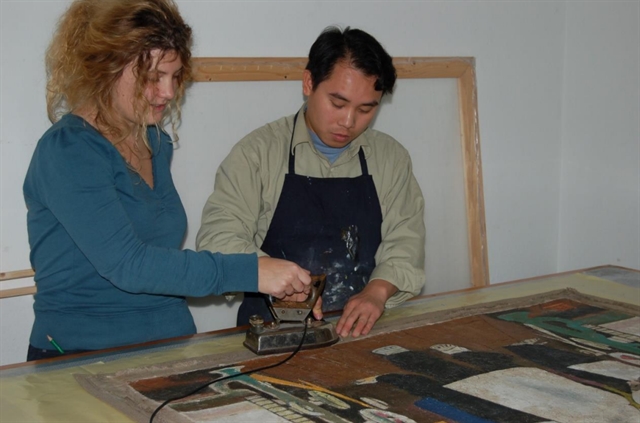The Vietnam Fine Arts Museum held a scientific seminar titled "Inventory and preservation of artefacts at Fine Arts Museums in Vietnam - Current situation and solutions" to strengthen collaboration between fine art museums across the country, and together exchange and share experiences on inventory, preservation and management of artefacts.
 |
| Foreign experts assist in preserving paintings at the Việt Nam Fine Arts Museum. Photo VNA/VNS |
Nguyễn Anh Minh, Director of the Việt Nam Fine Arts Museum affirmed that the inventory of artefacts is one of the most basic but important professional activities of every museum, which affirms and ensures the scientific condition and legality of each artifact.
Preservation to prolong the life of artefacts, as well as proper management, is an important task for each museum. Management, documentation, and digitization are basic professional activities to ensure a museum operates effectively.
In recent years, the Ministry of Culture, Sports and Tourism, as well as provinces and cities that support the inventory, have helped to preserve and manage artefacts at fine art museums.
Art museums also have taken the initiative from their limited resources to apply technology, building databases for collections and scientific records for artefacts that meet international standards.
Fine art museums across the country still face difficulties and limitations. Basic warehouses and preservation equipment is still lacking in both quantity and quality, not meeting the needs and long-term requirements of the works of art.
“Exhibition spaces have not invested in air conditioning systems, dehumidifiers, or proper lighting systems based on international standards, and often lack technical equipment such as light and radiation meters.
"The works on display are directly affected by environmental and human factors, which significantly affect their condition,” said Đinh Thị Hoài Trai, Director of Huế Fine Arts Museum.
Contributing ideas at the seminar, Trương Nguyễn Nguyên Kha, Head of the Operations Department of Đà Nẵng Fine Arts Museum proposed digitising inventory and preservation methods.
“We need to build software that is convenient and suitable for art museums to perform data entry and control the search and management of the museum's artefacts in a more scientific way," Kha said.
Trai also shared the same idea and added the need to improve the qualifications and capacity of the museum's management and staff.
Phạm Định Phong, Deputy Director of the Department of Cultural Heritage said that public and private museums need to strengthen cooperation and share experiences, forming an in-depth network on the preservation of art objects.
“We have learned many painful lessons from improper preservation of artworks. In fact, experts in one kind of artefact may not have preserved and taken good care of another type. Therefore, professional training and experience exchange is essential among museums,” Phong said. – VNS